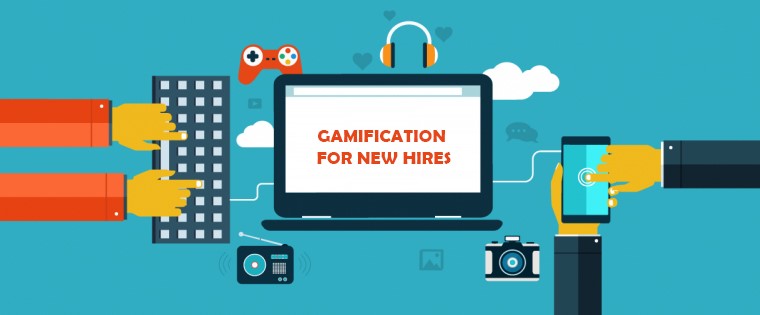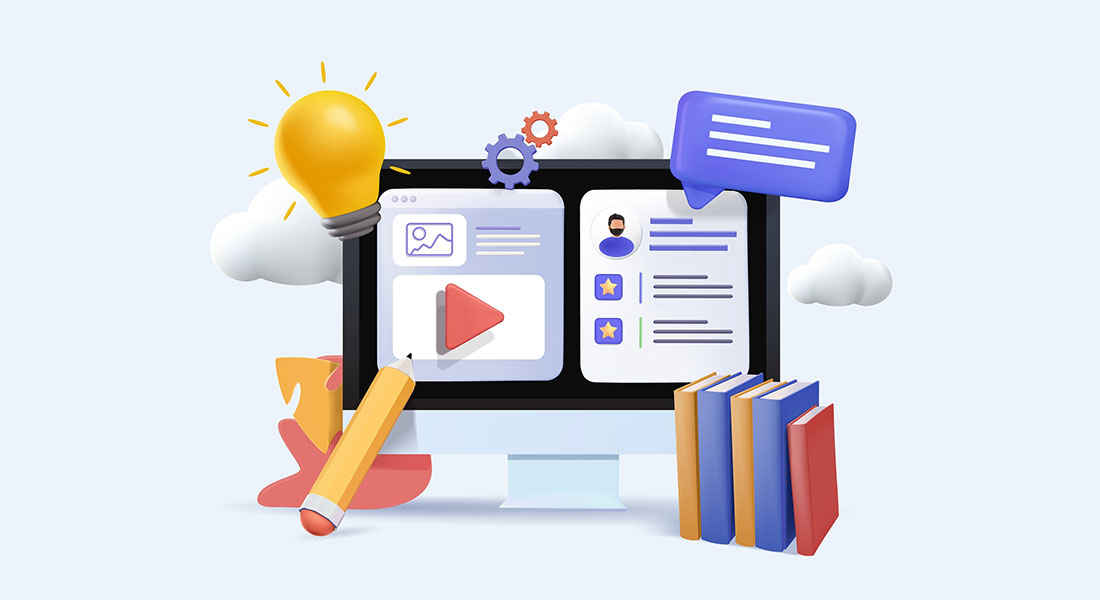Custom eLearning + Gamification = Next-Level Corporate Training
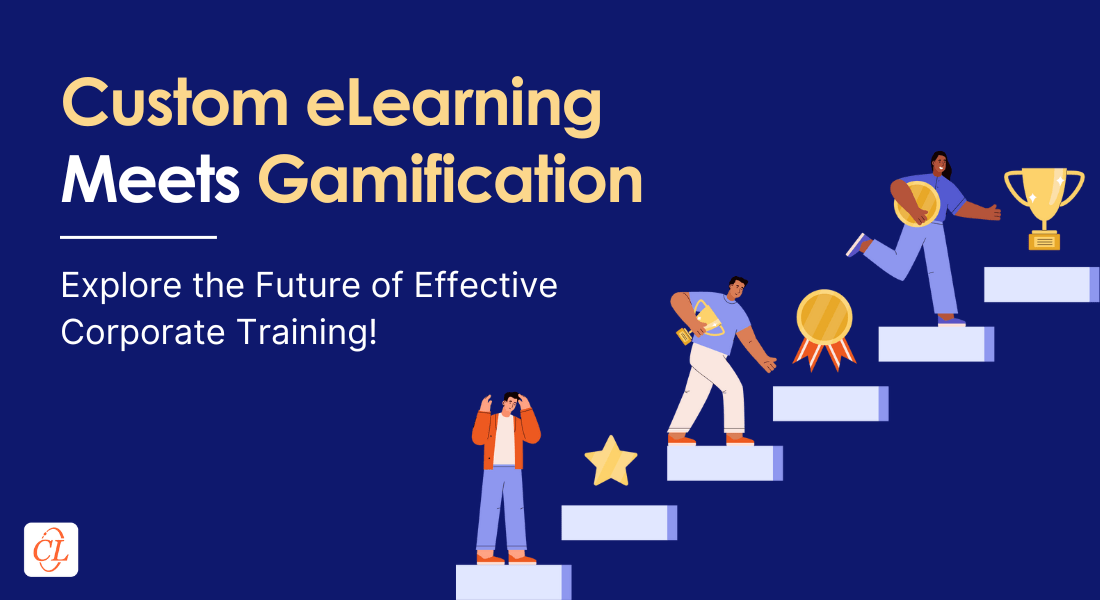
In today's rapidly evolving business landscape, the need for skilled and adaptable employees is paramount. Traditional employee training methods, however, often fall short in meeting these demands. Lengthy lectures, outdated materials, and one-size-fits-all programs can lead to disengagement, low knowledge retention, and a disconnect between training and real-world application. Custom eLearning, with its ability to tailor content and delivery to specific needs, has emerged as a powerful tool for employee development. When combined with gamification, which leverages the principles of game design to create captivating learning experiences, the possibilities for transforming employee training are boundless. In this blog, we will explore the limitations of traditional training methods and check out the benefits of custom eLearning and gamification.
→ Download eBook Now: How AI Supercharges Gamification
Table Of Content
- What is Custom eLearning?
- What is the Importance of Gamification in Learning?
- What You Need to Get Right about Gamification
- How to Combine Custom eLearning and Gamification?
- What are the Best Practices for Implementing Custom eLearning and Gamification?
- How to Measure the ROI of Custom eLearning and Gamification?
- How to Overcome Challenges in Implementing Custom eLearning and Gamification?
- Why is Articulate Storyline an Ideal eLearning Authoring Tool for Gamification?
- What is the Future of Custom eLearning and Gamification?
What is Custom eLearning?
In the pursuit of impactful and effective corporate training, custom eLearning solutions has emerged as a formidable solution to address the limitations of traditional employee training and development methods. At its core, custom eLearning refers to the development of tailor-made training materials and experiences designed to specifically address the unique learning objectives, needs, and context of an organization and its employees.
Unlike generic, off-the-shelf training programs, bespoke eLearning offers the distinct advantage of personalization. Content, delivery methods, and assessments can be meticulously personalized to align with the specific roles, responsibilities, and skill gaps of employees within a particular company. This tailored approach ensures that learners receive information that is directly relevant to their work, enhancing engagement and knowledge retention.
Discover why custom eLearning is a game-changer for advanced organizations looking to stay ahead in today's competitive landscape!
What is the Importance of Gamification in Learning?
Gamification has now been adopted by more than 70% of businesses belonging to the Global 2000 list of companies.
Source: Gartner
Gamification, the strategic integration of game design elements into non-game contexts, has emerged as a transformative force in the realm of Learning and Development (L&D). By harnessing the inherent appeal and motivational power of games, gamification infuses the learning process with a sense of enjoyment, challenge, and achievement, leading to heightened engagement and improved learning outcomes.
At its core, gamification operates on a set of core principles that tap into fundamental human psychological needs. The use of points, badges, leaderboards, and other reward systems creates a sense of progress and achievement, fueling intrinsic motivation. Competition and challenges foster a sense of excitement and encourage learners to push their boundaries. Narrative elements and storytelling can provide context and meaning, making the learning experience more immersive and memorable.

What You Need to Get Right about Gamification
MYTH 1: Gamification is all about Points, Badges, and Leaderboards
Gamification is NOT just about incorporating points, badges, and leaderboards (PBLs). They are just completely meaningless on their own. Why exactly is Google providing those badges? What will readers gain if they have those badges? Nobody knows.
According to Yu-Kai-Chou, the author of Actionable Gamification, gamification is more about how, when, and why game elements appear in a context. Suppose you are planning to deliver a gamified eLearning course, just incorporating points or badges randomly within the course will not lead to achieving the ultimate learning objectives or business objectives. It is about choosing the right game elements in the right context to accomplish the goals.
For example, the modules within the course can be divided into levels. Modules can be arranged in the order of difficulty within the course, thus implying the higher the learners reach, the difficult the learning gets. If and only if they clear a level, can they move on to the next one. Each time they clear a certain level, badges/points can be provided which will be visible on their LMS dashboard.
Also keep in mind that game elements include not just the PBLs but various other elements such as the rules, levels, storytelling, and reward structure, which when used appropriately will lead to an extremely immersive and effective learning experience.
MYTH 2: Gamification and Game-based Learning are the Same
In the eLearning world, both gamification and game-based learning are often heard together and hence individuals end up confused. While gamification is the incorporating of game elements within an eLearning course to instill motivation, game-based learning is all transferring/building skills knowledge through a game. In game-based learning, the game itself is the training.
| Game-Based Learning | Gamification |
|---|---|
| 1. Using games to meet learning objectives | 1. Adding game elements in the right context in courses |
| 2. Learning comes from the game itself | 2. Game elements bring out the desired behavior |
| 3. Facilitates intrinsic motivation | 3. Facilitates extrinsic motivation |
MYTH 3: It’s NOT the Right Choice for Corporate Training
It might be true that gamification does not work for everyone. But neither does taking up hour-long training sessions or reading reams of text. Some people might argue that gamification might lead to more of entertainment and less of learning.
Well, that is not the case. The ultimate aim of corporate training is to make your employees efficient enough to carry out particular tasks. It may be memorizing a few laws and being able to apply them to stay compliant or learning to execute tasks within a software – gamification will definitely help you meet your learning objectives.
The fun factor within gamifying your course will in fact lead to learners embracing the training even more. Once the learner embraces the course, engagement levels will raise leading to better retention of knowledge.

Winning the eLearning Engagement Game: How AI Supercharges Gamification
Experience the Future of eLearning Engagement with AI-enhanced Gamification!
- Games to Engage Modern Learners
- Practical Tips to Incorporate Gamification in eLearning
- AI-enhanced Gamification
- And More!
How to Combine Custom eLearning and Gamification?
The true potential of transforming employee training lies in the synergistic combination of custom eLearning design and gamification. By integrating game design elements into tailor-made learning experiences, organizations can create highly engaging, interactive, and effective training programs that cater to the unique needs and preferences of their workforce. Here’s an example of how gamification and custom eLearning can be combined for effective results.
New sales representatives embark on an exciting "Sales Quest," their personalized journey through a gamified onboarding platform. Powered by AI, their learning adapts in real-time, guiding them through product knowledge, sales techniques, and company culture. Virtual reality simulations empower them to practice sales pitches and handle objections, earning points for success. Bite-sized mobile lessons reinforce key concepts, and a collaborative platform encourages knowledge sharing with experienced colleagues.
Progress is visually tracked with leaderboards and level-ups, creating a sense of achievement and friendly competition. This immersive blend of technology and gamification accelerates onboarding, boosts knowledge retention, and motivates new hires to reach their full potential. The result? A skilled and confident sales team ready to conquer real-world challenges, contributing to the company's growth while enjoying a rewarding and engaging learning experience.
This hypothetical yet practical example showcases how cutting-edge technologies and gamification principles can be seamlessly integrated to create highly effective and engaging employee training and development programs in 2025 and beyond.
What are the Best Practices for Implementing Custom eLearning and Gamification?
Want to Explore the Powerful Combo of Custom eLearning and Gamification?
Here are a few best practices to implement them
- Set Clear Learning Objectives
- Conduct a Thorough Needs Assessment
- Design Engaging Content
- Integrate Gamification Thoughtfully
- Foster a Culture of Learning
While the combination of custom eLearning and gamification holds immense promise for revolutionizing employee training, successful implementation requires careful planning and adherence to best practices.
Here's a step-by-step guide to help organizations effectively integrate these powerful tools into their L&D initiatives:
1. Set Clear Learning Objectives
Begin by defining specific, measurable, achievable, relevant, and time-bound (SMART) learning objectives. What skills, knowledge, or behaviors do you want employees to acquire through the training? Having clear objectives will guide the eLearning design and ensure its alignment with organizational goals.
2. Conduct a Thorough Needs Assessment
Identify the specific training needs of your target learners. Consider their existing skill levels, learning preferences, and any challenges they may face. Gather feedback from employees and managers to gain insights into areas where training can have the greatest impact.
3. Design Engaging Content
Craft eLearning content that is visually appealing, interactive, and relevant to learners' roles and responsibilities. In corporate multimedia elements, real-world scenarios, and storytelling to enhance engagement and knowledge retention. Ensure that the content is accessible across various devices and platforms.
4. Integrate Gamification Thoughtfully
Choose gamified elements that align with your learning objectives and target learners. Use points, badges, leaderboards, and other rewards to incentivize participation, track progress, and foster a sense of accomplishment. Incorporate challenges, quizzes, and simulations to promote active learning and knowledge application.

5. Provide Continuous Feedback and Support
Offer learners regular feedback on their progress and performance. Encourage them to ask questions, seek clarification, and collaborate with peers. Provide access to resources and support materials to facilitate learning and address any challenges they may encounter.
6. Evaluate and Iterate
Regularly assess the effectiveness of your eLearning courses and gamification strategy. Gather feedback from learners, track completion rates, and measure knowledge acquisition and behavior change. Use this data to refine your approach and continuously improve the learning experience.
How to Measure the ROI of Custom eLearning and Gamification?
While the qualitative benefits of custom eLearning and gamification are evident, it is crucial for organizations to also quantify the impact of these strategies on their bottom line. Measuring the return on investment (ROI)provides concrete evidence of the effectiveness of training initiatives and helps justify the investment in these approaches.
Several key metrics can be used to evaluate the ROI of bespoke eLearning and gamification:
- Completion Rates: Track the percentage of learners who successfully complete the training program. High completion rates indicate strong engagement and motivation.
- Assessment Scores: Measure learners' performance on quizzes, tests, and simulations to gauge knowledge acquisition and skill development.
- Employee Engagement and Satisfaction Surveys: Collect feedback from learners on their experience with the training program. High levels of engagement and satisfaction correlate with improved learning outcomes.
- On-the-Job Performance Improvements: Observe and measure changes in employee performance following the training. This can include increased productivity, reduced errors, or improved customer satisfaction scores.
- Cost Savings: Compare the cost of custom eLearning and gamification to traditional training methods. Consider factors such as travel expenses, instructor fees, and lost productivity due to time away from work.
How to Overcome Challenges in Implementing Custom eLearning and Gamification?
While the benefits of custom eLearning and gamification are undeniable, organizations may encounter certain challenges during the implementation process. Recognizing and addressing these potential hurdles proactively can ensure a smooth and successful transition to these innovative training approaches.
1. Cost
Developing custom eLearning content and integrating gamification elements can require an initial investment in terms of time, resources, and technology. Organizations may need to allocate a budget for instructional designers, content creators, and potentially specialized software or platforms. However, it's important to consider the long-term cost savings and ROI associated with these approaches, such as reduced travel expenses, decreased instructor fees, and improved employee productivity.
2. Technology
Implementing gamification and deploying eLearning content may necessitate new technologies or upgrades to existing systems. Organizations need to ensure that their learning management system (LMS) and other infrastructure can support the delivery of interactive and engaging content. Careful planning and collaboration with IT teams are essential to ensure a seamless technological integration.
3. Employee Buy-in
Some employees may be resistant to change or skeptical of new training approaches. Organizations need to proactively communicate the benefits of custom eLearning and gamification, emphasizing the personalized learning experiences, increased engagement, and opportunities for skill development. Providing clear instructions, offering support, and recognizing and rewarding participation can help foster employee buy-in and enthusiasm for these new initiatives.
4. Time
Creating engaging and effective eLearning content, especially when tailored to specific needs, can be time-consuming. Organizations may face challenges in balancing the need for quality content with the urgency of training delivery. Streamlining the development process by leveraging eLearning authoring tools to help expedite content creation without compromising quality.

Winning the eLearning Engagement Game: How AI Supercharges Gamification
Experience the Future of eLearning Engagement with AI-enhanced Gamification!
- Games to Engage Modern Learners
- Practical Tips to Incorporate Gamification in eLearning
- AI-enhanced Gamification
- And More!
Why is Articulate Storyline an Ideal eLearning Authoring Tool for Gamification?
There are countless eLearning authoring tools available today, each offering unique features to enhance digital learning experiences. However, when it comes to creating engaging, interactive, and gamified content, Articulate Storyline stands out as a top choice. Let’s see why!
1. It is Easy to Use
Articulate Storyline is a powerful authoring tool, yet is easy to use and handy for instructional designers. With the PowerPoint-like user interface, it is easy for anyone to use. The GUI is customizable and can be modified as per your need by altering its colors or by incorporating additional components. An added feature is that this tool has various inbuilt components. You don’t have to struggle to come up with your own design or components. For instance, we developed a game for one of our clients, with a simple user interface, that was easy to understand and easy to play. At the same time, it provided an enhanced learning experience to the learners.
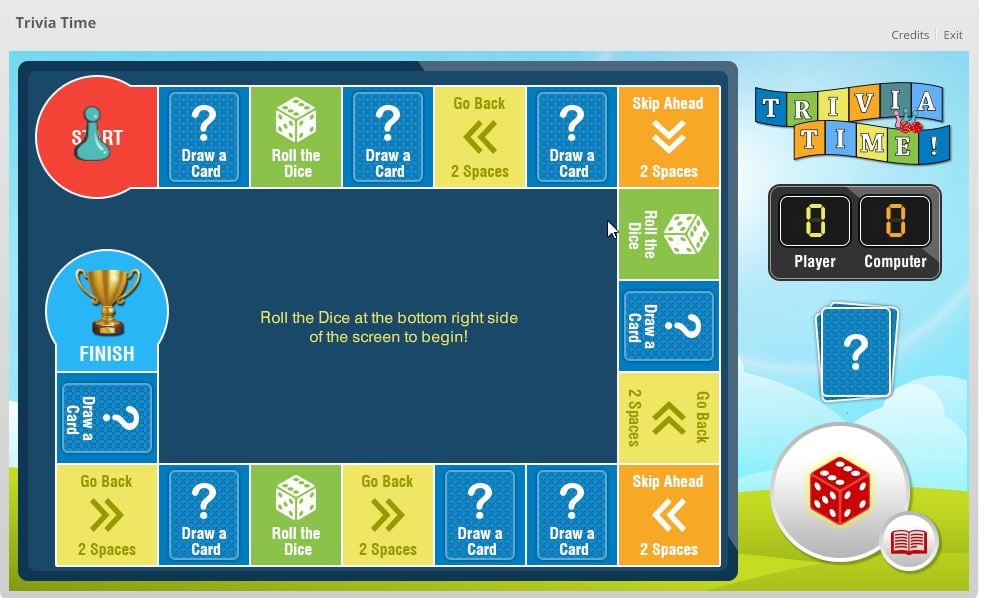
2. It Supports Instructional Design Strategies
Articulate Storyline is an instructional designer’s dream tool. It allows for free flow of thought, without limitations or restrictions in terms of design or tool capabilities. Whatever be the thought or idea, it can be converted into reality. For instance, one of our clients needed a game-based approach to track if their employees were able to make strategic managerial decisions as well as operational choices. We developed a scenario-based game, using Articulate Storyline. The game had a combination of simple and complex instructional design strategies that made it interesting and engaging. As it was a scenario-based game, it included various characters in an office. The design was easy to develop and customize.
This is one of the main reasons we prefer Articulate Storyline for game-based courses. With other authoring tools, designing and developing complex games is really complex. The designer-friendly and user-friendly templates of Articulate Storyline make it easy to make a game-based course a reality. We were able to create the game-based course in a little over two weeks. If the same game were to be developed using Flash, it would’ve taken much longer. This tool also makes it easy to integrate videos and resources from other sources.
3. It Gives the Liberty to Develop Interactivities
Another game-based approach we used with Storyline had participants answering a series of 12 questions to win $10,000, a little like ‘Who Wants to be a Millionaire?’ to effectively engage learners. We used the tool’s inbuilt resources and customized them to suit our needs. What we got at the end was an interactive and engaging game-based course. Watch CommLab India’s sample course in action!

Based on the popular game Tic-Tac-Toe, we developed a game called Bouquets & Brickbats. We customized this game to suit our needs and integrated it with videos and from other sources. We also effectively used the inbuilt templates and functions of Articulate Storyline.
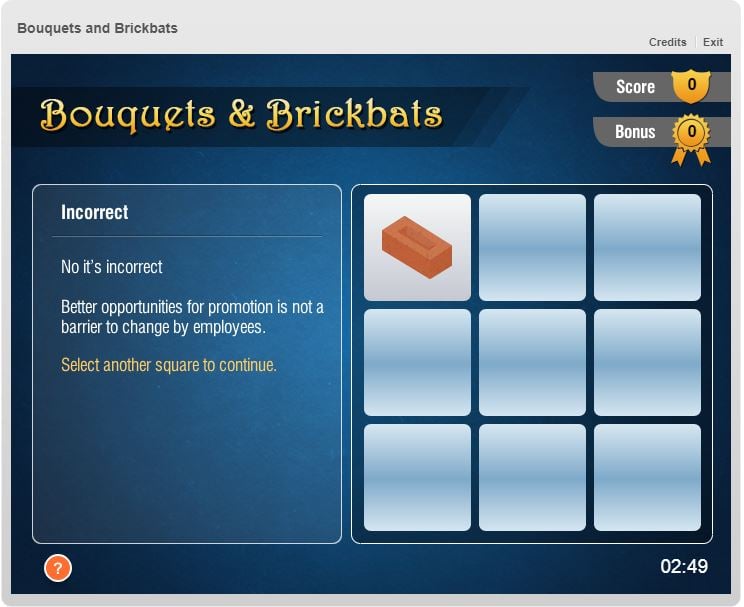
What is the Future of Custom eLearning and Gamification?
The landscape of employee training is constantly evolving, driven by advancements in technology and changing learner expectations. As we look to the future, several exciting trends and technologies are poised to shape the next generation of custom eLearning and gamification:
1. Artificial Intelligence (AI) and Machine Learning
AI and machine learning algorithms can be leveraged to create highly personalized learning experiences that adapt to individual learner needs and preferences. These technologies can analyze learner data to identify knowledge gaps, recommend relevant content, and provide tailored feedback, optimizing the learning process for each learner.
Discover how AI-driven gamification can transform corporate training into an engaging and effective experience!
2. Virtual Reality (VR) and Augmented Reality (AR)
VR and AR offer immersive and interactive training environments that simulate real-world scenarios and challenges. Learners can practice skills and make decisions in a safe and controlled environment, enhancing their confidence and preparedness for on-the-job situations.
3. Mobile Learning
With the increasing prevalence of smartphones and tablets, mobile learning enables employees to access training materials anytime, anywhere. This flexibility allows for just-in-time learning and accommodates the diverse schedules and learning preferences of today's workforce.
Leveling Up!
Custom eLearning, tailored to specific needs and objectives, offers a powerful solution for enhancing employee development. When combined with the motivational and interactive elements of gamification, the potential for transforming employee training is truly remarkable. If you are keen to learn more about the impact of AI and how it can supercharge gamification, you should definitely check out CommLab India’s eBook!




